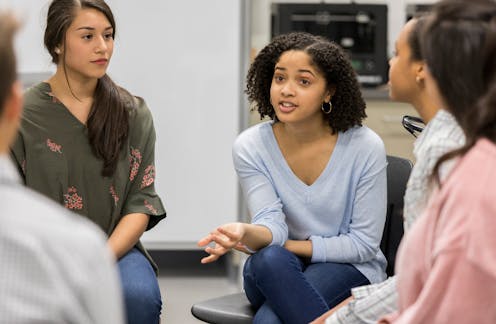Latino youth struggle with sense of belonging in school
Latino youths often feel more at home in after-school programs and in the community than they do in school. A sociologist explores why.

The Research Brief is a short take about interesting academic work.
The big idea
Latino youth in middle and high school have a lower sense of belonging at school and in the community overall when compared with white peers. That is a key finding from my analysis, which is currently under review and based on surveys with students in midsize districts – one urban and one suburban – on the East Coast. I also found that being a language learner is associated with lower school belonging.
To measure belonging, I analyzed a 40-question survey that included questions about belonging at school, in after-school programs and in the community. Students reported that the reasons for feeling a lack of belonging stem from negative experiences at school, few trusting adult-student relationships and little affirmation from school of students’ Latino identity. Latino youths, especially those from immigrant households and nonnative English speakers, report lower sense of belonging.
One Latina middle schooler explained: “I am from two places, El Salvador and Honduras, but I mostly use Hispanic, or I say I am from Honduras.” This teen is proud of her identity but feels it is rare to see someone like her and worries about being accepted in school because of her multicultural identity.
Some young people worry about racial discrimination and immigration policies that affect their families. One Latina youth stated: “I get worried sometimes we might get deported,” demonstrating her isolation.
Belonging generally relates to feeling accepted, included, respected and supported. My research found that Latino youths with lower sense of belonging report feeling unimportant in school, have negative or unsupportive interactions with adults, and have just one or no adults to ask for help. In my research, “I don’t feel like I belong” was a common phrase from youths. Even before the pandemic, adolescents broadly were reporting feelings of isolation and negative mental health effects.
Latino youths in this project also reported higher belonging if they are connected to peers with similar ethnic or immigrant family identities. Additionally, Latino youths tend to have stronger relationships with adults outside of school – such as in their community or at after-school programs – than in school. This is often because of the diversity in those out-of-school settings.
In fact, community spaces, such as public libraries or after-school programs, foster belonging and affirm identities and cultures. Frequently, these community spaces also connect Latino immigrant youths and their families to important resources, such as access to immigration attorneys, social workers and counselors, or scholarship information.
Why it matters
Latino students make up nearly 30% of U.S. public schools students. If school leaders are to improve academic outcomes and lessen negative mental health effects for Latino youths, belonging has to be part of the process.
Prior research has already demonstrated how academic outcomes are connected to belonging. Young people need to feel safe, respected and supported in order to succeed in school.
Relationships are critical for belonging. They must be focused on helping students succeed and include mutual respect with adults to affirm who they are. Otherwise, the resulting lower belonging can lead to less engagement with academics and lower graduation rates. These effects of low belonging limit youths’ future opportunities, such as by lowering their chances of going to college.
With a steadily rising Latino population across the U.S., many Latino students are from immigrant backgrounds and face language and economic barriers. It’s critical for educators to cultivate supportive relationships and affirm these students’ ethnic and immigrant identities.
What other research is being done and what’s next?
New research explores how to improve school environments and make them more responsive to Latino youths’ needs. As such, schools should honor identities and cultures.
This can happen through improving educator awareness and training about how immigration affects students’ lives and families, reducing segregation in schools and bias toward nonwhite students, and valuing students’ cultures.
Schools can also partner with community-based organizations, since research shows these organizations are where young people have a higher sense of belonging and more positive adult-student relationships.
Sophia Rodriguez receives funding from William T. Grant Foundation.
Read These Next
From truce in the trenches to cocktails at the consulate: How Christmas diplomacy seeks to exploit s
World leaders like to talk up peace at Christmastime. But alongside the tales of seasonal breaks in…
How to reduce gift-giving stress with your kids – a child psychologist’s tips for making magic and a
Depending on family circumstances and a child’s personality type, gift giving runs the gamut of fun…
The world risks forgetting one of humanity’s greatest triumphs as polio nears global eradication − 7
Polio may finally be defeated in the next 5 years. Will the world recognize what an extraordinary achievement…






